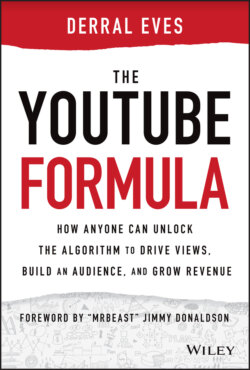Читать книгу The YouTube Formula - Derral Eves - Страница 18
Beware of Copyright
ОглавлениеThe first consideration in the ecosystem should be the viewer. If nobody is coming around to watch, the rest of the ecosystem is dead in the water. When YouTube was new, the viewers were a fairly specific demographic because the content was fairly specific. People were uploading personal videos to share with their friends and family, so there was an audience there, but where the viewership really had the potential to grow pushed in the entertainment direction. People were uploading clips from TV shows, movies, comedy bits, and the like. Viewers were also coming to find clips from popular culture and the news. It was easy to upload this stuff, and it was easy for the viewers to find.
From 2005 to early 2007, YouTube users had been uploading content generally unregulated and unsupervised. This included a lot of original content, sure, but it also included protected content that had been created by another person or company. Obviously, this was a direct infringement to the copyright holder of that content.
It's important to note here that YouTube users weren't doing this sneakily or maliciously. They just wanted to share things they loved, and it was so easy to do. Do you remember Napster from the turn of the century? For those of you born in the 2000s, let me tell you a story.
Imagine a world where you couldn't listen to your favorite music on demand. The only way to hear your favorite song was to sit by the radio all day, waiting. If you wanted to listen on demand, you had to buy the entire album that included the one song you wanted to hear. Then along came Napster. Napster was the original widespread file‐sharing platform. Like, the pioneer of all digital media sharing on the Internet. Audio files, mostly songs, were shared as MP3 format files, and anyone could download any file for free. FREE! This was huge for music fans all over the world—the people loved Napster. Who wouldn't want unlimited access to their favorite bands for exactly zero dollars? Well, I guess not quite everyone was a Napster fan … namely, anyone who should be making money from music sales.
If you don't know the rest of the story, I bet you can guess what happened next. Lawsuits. Shut down. No surprises here. Actually, just before Napster was created, Bill Clinton, then‐president of the United States, had signed the Digital Millennium Copyright Act (DMCA) into law in 1998. The DMCA has regulated digital copyright issues and reinforced offender penalties ever since. (However, websites hosted outside the US are regulated by the United Nations World Intellectual Property Organization (WIPO).) What happened with Napster set the stage for media sharing regulation from that point forward.
YouTube could have looked at companies like Napster as examples of what not to do, and implemented their Content ID system from the time they opened up shop in 2005, but they didn't. In March 2007, a little company called Viacom, along with several others, sued Google and YouTube for $1 billion worth of copyright infringement issues. Reuters reported that YouTube was only taking copyrighted content off the site after a copyright owner had requested it, but there was nothing being done on the front end to prevent that content from being uploaded to begin with. Further, the lawsuit claimed that YouTube knowingly let this happen because they were making money on all that content.
The Content ID system wouldn't be implemented until 2007, the beta in June and full rollout in December. The ID system would attach a unique “digital fingerprint” to new uploaded content. Content could then be tracked and measured against already existing copyrighted content so YouTube could catch infractions.
Now that the law had been involved, YouTube had to settle some things for copyright holders. First, they literally had to settle that hefty lawsuit (the terms of settlement were undisclosed), but they also had to settle how they would proceed from there, and the Content ID system was the answer. I can't stress enough how monumental this was to YouTube's success. YouTube likely would have followed the fate of the original Napster and been shut down if the Content ID system hadn't been implemented, and a lot of creators and businesses like you and me would be doing something else. It was a total game changer.
